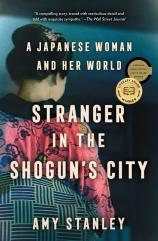Stranger in the Shogun's City: A Japanese Woman and Her World
Review
Stranger in the Shogun's City: A Japanese Woman and Her World
“History often comes to us before we know we’re looking for it,” so said an unusually enlightened high school teacher during a late 1960s senior class debate we had about whether or not our decade would be considered “historical.” Looking back more than half a century, it seems amazingly naïve that the question should ever have been posed.
One could say the same about a 19th-century Japanese woman whose brief existence comes vividly to life amid cataclysmic global changes in Amy Stanley’s STRANGER IN THE SHOGUN’S CITY.
Tsuneno (1804-1853), the daughter of a moderately comfortable rural priest in Ishigami Village whose ancestors had been powerful samurai, was so ordinary for her time that traditional historical accounts should have let the memory of her life simply fade into obscurity. Yet all around her, feudal Japan and its 250-year-old Tokugawa shogunate rulers were undergoing relentless pressure to “open” the ancient country to the rest of the world. It was indeed a historical time even if Tsuneno herself was unaware of it.
What made Tsuneno and her family unusual, however, were the priceless assets of literacy and record-keeping. Although educated only to know how proper girls and women must behave --- speak softly, sit still, stay in the background, obey family authority --- she could read and write capably, using her pen frequently and well to voice her needs and opinions.
"[I]t often reads like a novel or biography, but every turn of phrase remains steadfastly true to historical fact. Nearly 90 pages of notes, bibliography and indexing attest to Stanley’s diligent and painstaking research."
Carefully archived and catalogued along with the bulk of her family’s correspondence, Tsuneno’s letters, lists and expense diaries remain as small but important pieces of a mosaic that Stanley has elegantly and expertly reassembled into a life. In fact, the first thing one notices about STRANGER IN THE SHOGUN’S CITY is that it often reads like a novel or biography, but every turn of phrase remains steadfastly true to historical fact. Nearly 90 pages of notes, bibliography and indexing attest to Stanley’s diligent and painstaking research.
Although Japanese girls of the time were wed in their early teens to husbands of their parents’ choosing, divorce was not stigmatized; even multiple divorces would not lessen a woman’s eligibility for marriage as long as she was still of child-bearing age. Tsuneno went through at least three arranged marriages and divorces before taking matters into her own hands during her 30s and striking out on her own to make a new life 200 miles away in the vast city of Edo (later Tokyo), which even then was home to more than a million people.
Diverting from her family’s plans and traditions made her something of a rebel, a frustration and an embarrassment, especially for an older brother who took on the role of patriarch when their father died. Their correspondence was often testy and complaining, but Tsuneno usually proved quite skillful in getting her way when she needed financial support and other favors.
Some of the most interesting pages throughout STRANGER IN THE SHOGUN’S CITY are those in which the reader becomes an inside observer as Tsuneno, with various residences, partners and occupations, struggles to survive in a teeming and competitive city. One learns of clothing styles, social classes, entertainment, political upheavals, religious practices, occupations, climate, tremendous fires, transportation --- myriad details of everyday life that we take for granted in our own time, but that seem exotic when experienced nearly two centuries earlier.
Stanley is particularly detailed in describing life under an extreme austerity “reform” campaign imposed by the ruling shogun’s inner circle after Tsuneno had lived in Edo for a number of years. A haunting preview of the decade-long Cultural Revolution (1966-1976) that devastated Communist China, the Tenpō Reforms of the 1840s traumatized an entire city with such strict limits on clothing styles, entertainment, food and personal conduct that many cultural traditions were lost forever.
Through good times and bad, suffering and comfort, love and abandonment, poverty and wealth, Tsuneno stoically kept on looking for a better life. Perhaps she found it during long gaps of little or no letter-writing or list-keeping; there are many such speculations as Stanley traces her subject’s meandering and often tangled path.
What we do know is that Tsuneno’s dream of returning home to Ishigami to retire and die peacefully at an advanced age would not come to fruition. She passed away in Edo at barely 50 years of age. Nor are there any documented biological children who may have carried on her legacy. But she was given a place in history nonetheless, an “ordinary” woman who, thanks to Stanley’s measured and empathic prose, lives for us again in the 21st century.
When I opened the cover of STRANGER IN THE SHOGUN’S CITY, I wasn’t consciously looking for history either, but it found me…and I found much more.
Reviewed by Pauline Finch on July 31, 2020
Stranger in the Shogun's City: A Japanese Woman and Her World
- Publication Date: July 6, 2021
- Genres: History, Nonfiction
- Paperback: 352 pages
- Publisher: Scribner
- ISBN-10: 1501188534
- ISBN-13: 9781501188534




